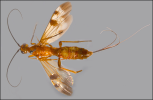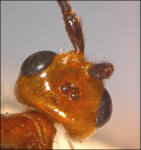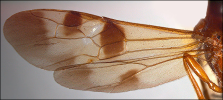 |
Scientific nameStenobracon (Stenobracon) deesae (Cameron)
Taxonomic positionHymenoptera: Ichneumonoidea: Braconidae
DiagnosisDorsal side more or less uniform yellowish-orange, wings yellowish grey with yellowish brown veins, apical margins brownish, fore wing with three blackish brown spots, hind wing with two fuscous spots (Fig. 1). Ovipositor nearly as long as body. Similar to S. nicevillei (Bingham) in general appearance, differs in the following characters: vertex of female largely yellowish brown (Fig. 3); fifth and sixth metasomal tergites yellowish (Fig. 2). Vein cu-a of fore wing may be far postfurcal (Fig. 4). Metasomal tergites 1-2 longitudinally strigose; tergites 3-4 largely rugose, basal protruding area smooth; tergites 5-7 with moderately long setae. Face of male widened, head dorsally partly yellow, very rarely completely dark; third tergite distinctly sculptured.
Chishti & Quicke (1996) provided a detailed description and keyed both sexes of the species.  Fig. 1. Adult female, dorsal view Fig. 1. Adult female, dorsal view Fig. 2. Gaster, female Fig. 2. Gaster, female Fig. 3. Head, female Fig. 3. Head, female Fig. 4. Wing venation Fig. 4. Wing venation
Distribution
India (widely distributed almost throughout the country); Pakistan; Malaysia; China; South Palaearctic and Afrotropical (Chishti & Quicke, 1996; van Achterberg & Walker, 1998)
Hosts / BiologyIt is a solitary larval ectoparasitoid of graminaceous stem borers such as Chilo
partellus Swinhoe, C. infuscatellus Snellen, C. sacchariphagus indicus (Kapur), C. auricilius Dudgeon, C. suppressalis (Walker), C. tumidicostalis (Hampson), Scirpophaga excerptalis (Walker), S. incertulas (Walker), S. innotata (Walker), S. nivella (F.), Emmalocera depressella (Swinhoe), Acigona steniellus (Hampson) and Sesamia inferens (Walker) on rice, sugarcane, sorghum and maize and is commonly collected (Chishti
& Quicke, 1996; Achterberg & Walker, 1998).
Also known to parasitise Corcyra cephalonica (Stainton), Bombyx mori (L.), Euproctis lunata Walker, Galleria mellonella (L.), Pectinophora gossypiella (Saunders), Phthorimaea operculella (Zeller), and Raphimetopus ablutellus (Zeller) in the laboratory (Shenefelt, 1978). References
|
